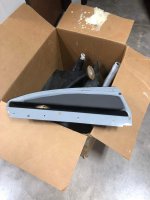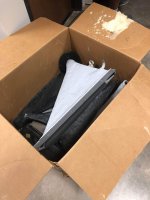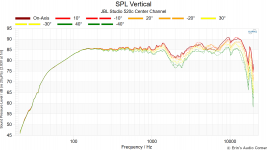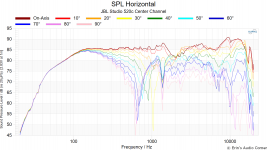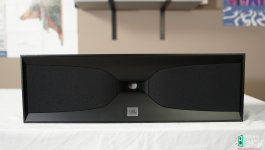No, amps and electronics hold no interest to me. They make almost no difference in sound quality, while speakers and rooms dominate the problem. I'm more interested in those things that matter.
I apologise for resurrecting very old posts and discussions – but remarks like these are absolutely current. Some ppl tell me I should try a triode amp or some boutique DAC. With my Topping D90 and a self-assembled Purifi/Neurochrome power amp I have essentially the SotA there, and any further change to source and amplification, even some horribly expensive ones, will be dwarfed but even minimal changes to the speakers and the room.
If everybody were as wise as you are, Earl, a whole snake oil industry would just vanish in an instant for good!
If everybody were as wise as you are, Earl, a whole snake oil industry would just vanish in an instant for good!
That's why they criticize my views.
Tube amps do make a difference in sound, they detune a passive x-over. It may sound "better" to some, but it's not what the speakers were designed to do, so, to me, it's not right.
There is a category of amps that I believe I've heard Earl reasonably refer to as broken. Say, those with too much crossover distortion, and those that have too much higher order harmonic distortion which may be connected with incorrect feedback technique. Also valve amps that were designed for simple but excessive harmonic distortion.
I for one don't allow a finite output impedance to interfere with a speaker or passive crossover in an unwanted frequency dependent way.
However there was a time when I searched for a distortion profile that would help to gloss over other problems in my system. This was before I learned to fix those properly. Now I find that I object to excessive amounts of distortion.
I for one don't allow a finite output impedance to interfere with a speaker or passive crossover in an unwanted frequency dependent way.
However there was a time when I searched for a distortion profile that would help to gloss over other problems in my system. This was before I learned to fix those properly. Now I find that I object to excessive amounts of distortion.
With current 3D printing, it is probably more effective to use honeycomb structure.Hi,
I was reading through the thread and also looked for the original patent to learn more details. I saw that the patent expired "fee-related" in 2018.
I'm not an expert on patents, but it reads to me that the solution is no longer covered by the patent.
US7708112B2 - Waveguide phase plug
- Google Patents
What do you think about it?
Best regards
KH
... take the time you invest in arguing with people on social media about horn/speaker design and go out to your garage and build something instead, maybe take your dog for a walk or watch a movie with your wife. Your life will be much less frustrating. Make your contact info known and the people who are really interested in learning and that have an open mind WILL FIND YOU. Social media has become a toxic environment where people are more interested in arguing and insulting each other.
Todd nailed it. Spot on!
When I was young and had less understanding of people, I though the social media was a neat way to exchange ideas objectively. Now still young, I look at all kinds of media, and they are written in a way to make the title get noticed rather than conveying information and thoughts. We just need to get more knowledgeable somehow to break free.
Every time I get into an argument about car audio waveguides on Facebook I get banned, but here we go again:
Over on Facebook, a friend of mine made the argument that "none of your designs have worked properly though! Your assumptions of horns are based on sound theory but it's applied entirely wrong for a small, highly irregular and reflective environment. It doesn't help that a lot of it has been in a CX-5. My wife has one. It's a garbage audio vehicle! I don't waste my time trying anything in it. I've left the stock system completely alone. Technology does change. Physics and acoustics don't though."
As I see it, the entire paradigm of how "traditional" car audio waveguides are designed is flawed; I've tried dozens of times to make them myself, I've been making them since the 90s, and modern waveguide designs are simply better IMHO.
Here's some data to back up my claim:
1) There's some measurements that I personally made of commercially available car audio waveguides. You can see my data, from 2008, here: https://www.diyaudio.com/community/...learned-how-to-fix-a-horn.151376/post-1919727
2) Erin from Erin's Audio corner did a much more exhaustive set of measurements. His old website is DOA, but I pulled the data from the wayback machine. I've attached his data.
Over on Facebook, a friend of mine made the argument that "none of your designs have worked properly though! Your assumptions of horns are based on sound theory but it's applied entirely wrong for a small, highly irregular and reflective environment. It doesn't help that a lot of it has been in a CX-5. My wife has one. It's a garbage audio vehicle! I don't waste my time trying anything in it. I've left the stock system completely alone. Technology does change. Physics and acoustics don't though."
As I see it, the entire paradigm of how "traditional" car audio waveguides are designed is flawed; I've tried dozens of times to make them myself, I've been making them since the 90s, and modern waveguide designs are simply better IMHO.
Here's some data to back up my claim:
1) There's some measurements that I personally made of commercially available car audio waveguides. You can see my data, from 2008, here: https://www.diyaudio.com/community/...learned-how-to-fix-a-horn.151376/post-1919727
2) Erin from Erin's Audio corner did a much more exhaustive set of measurements. His old website is DOA, but I pulled the data from the wayback machine. I've attached his data.
Attachments
-
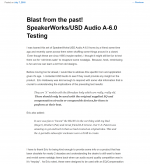 2022-05-04 13_50_20-.png309 KB · Views: 68
2022-05-04 13_50_20-.png309 KB · Views: 68 -
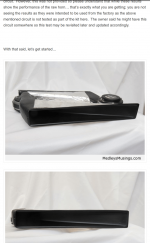 2022-05-04 13_50_59-.png179.8 KB · Views: 390
2022-05-04 13_50_59-.png179.8 KB · Views: 390 -
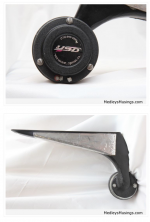 2022-05-04 13_51_24-Blast from the past! SpeakerWorks_USD Audio A-6.0 Testing _ Medley's Musings.png731 KB · Views: 63
2022-05-04 13_51_24-Blast from the past! SpeakerWorks_USD Audio A-6.0 Testing _ Medley's Musings.png731 KB · Views: 63 -
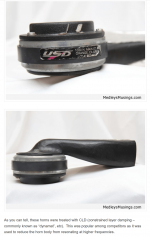 2022-05-04 13_51_49-Blast from the past! SpeakerWorks_USD Audio A-6.0 Testing _ Medley's Musings.png207 KB · Views: 61
2022-05-04 13_51_49-Blast from the past! SpeakerWorks_USD Audio A-6.0 Testing _ Medley's Musings.png207 KB · Views: 61 -
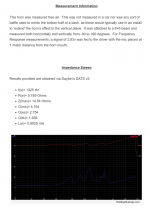 2022-05-04 13_52_16-Blast from the past! SpeakerWorks_USD Audio A-6.0 Testing _ Medley's Musings.png59.3 KB · Views: 61
2022-05-04 13_52_16-Blast from the past! SpeakerWorks_USD Audio A-6.0 Testing _ Medley's Musings.png59.3 KB · Views: 61 -
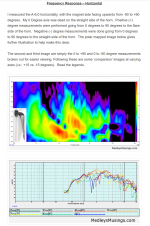 2022-05-04 13_52_59-.png523.6 KB · Views: 382
2022-05-04 13_52_59-.png523.6 KB · Views: 382 -
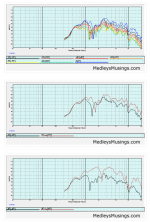 2022-05-04 13_53_32-Blast from the past! SpeakerWorks_USD Audio A-6.0 Testing _ Medley's Musings.png131.8 KB · Views: 386
2022-05-04 13_53_32-Blast from the past! SpeakerWorks_USD Audio A-6.0 Testing _ Medley's Musings.png131.8 KB · Views: 386 -
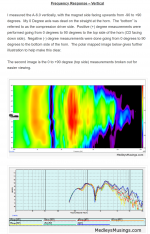 2022-05-04 13_54_48-Blast from the past! SpeakerWorks_USD Audio A-6.0 Testing _ Medley's Musings.png121.8 KB · Views: 355
2022-05-04 13_54_48-Blast from the past! SpeakerWorks_USD Audio A-6.0 Testing _ Medley's Musings.png121.8 KB · Views: 355
Here's some photos of the waveguides from Mark Eldridge's vehicle. I've never seen these pics before, very cool. I really enjoyed his episode of the podcast.
Attachments
Here's a car audio waveguide, commonly referred to as a "HLCD"
Here's a JBL Studio 520C. Similar width, height is about 2.5x taller. Both speakers use a horn loaded compression driver.
Here's the horizontal polars of the car audio waveguide
Here's the horizontal polars of the JBL Studio 520C
Here's the vertical polars of the car audio waveguide
Here's the vertical polars of the JBL 520C
Some observations:
Due to the fact that both speakers are very asymmetrical, performance isn't as good as you'd see with a symmetrical waveguide. But though the dimensions of the two waveguides is comparable, the JBL is superior in a number of ways:
1) It doesn't have a 15dB dip in the midrange
2) The off-axis response is comparable to the on-axis response
As someone who's designed more waveguides than I can count, I think the car audio waveguide has a midrange dip because of the reflector. Basically it's really challenging to get sound to make a 90 degree bend. Believe me, I've tried:
https://www.diyaudio.com/community/threads/cloning-a-3200-speaker-for-400.163015/
https://www.diyaudio.com/community/threads/square-pegs.217298/
So the first thing that should be done to the car audio waveguides is get rid of the completely pointless reflector in the throat. I am only aware of one or two car audio waveguides that didn't have one. I believe part of the reason they were there was because compression drivers were much bigger back in the 80s. Basically the reflector allowed car audio installers to install the horn and waveguide further back under the dash. But in 2022? No need, just use a neodymium compression driver.
The wide variance between the on and off axis response of the car audio waveguide is best solved by making them shallower. IMHO, a lot of 80s and 90s style car audio waveguides was inspired by Smith horns:
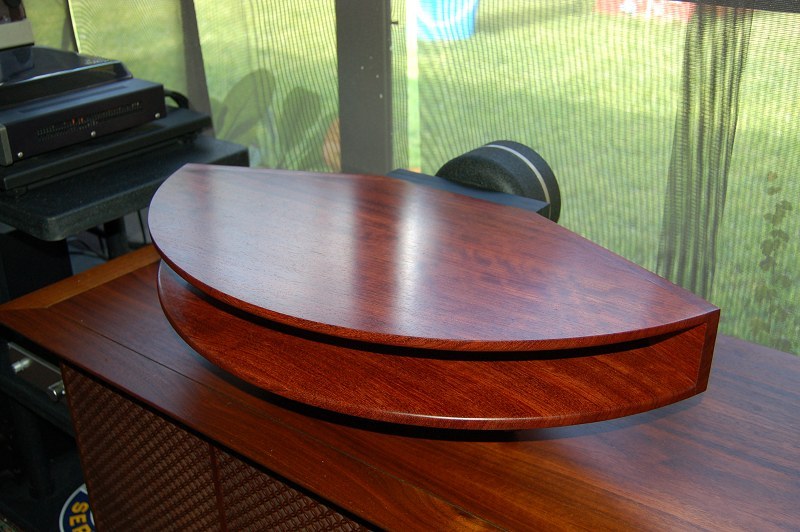
But Smith horns are from an era when amplifiers were much MUCH smaller. It's 2022; you can get compression drivers that are 109dB efficient for under $100 and ten watts will get them to ear splitting levels. Back when Smith horns were invented, amplifiers were more expensive, they were smaller, compression drivers were more expensive, bigger, and less efficient.
Modern waveguides like this aren't as efficient as an old school Smith horn, or a car audio HLCD. Basically when the depth of the horn is 2-3X smaller, you're going to lose efficiency on the low end. But modern waveguides have better polar response, wider beamwidth, smoother response. They're basically better in every way except one: they're not as efficient on the low end.
Pages 5, 6, and 7 of "Quadratic Throat Waveguides" does a great job of detailing the issues with traditional car audio HLCDs, Smith horns, and diffraction horns:
https://peaveycommercialaudio.com/w...atic-Throat-Waveguide-by-Charles-E-Hughes.pdf
I think it's particularly interesting that the author came from Electrovoice - so he was well versed in the flaws of the designs of the 70s and 80s.
One of the ironies here - is that I've designed and 3D printed tons of car audio HLCDs and waveguides with diffraction slots. And I'm certain I'll continue doing it, because being able to "have your cake and eat it too" is really compelling. Basically the idea that we can have a waveguide that provides significant gain AND directivity control is really compelling.
Even though I'd battled this problem for years, I think there's three fundamental challenges:
1) If you have a compression driver with a lot of low frequency displacement, it's going to be nearly impossible to improve upon the smoothness and beamwidth control that you get with something like an ATH CE360 (which is similar to an oblate spheroidal waveguide.) Basically, if maximum output and efficiency in the midrange isn't a big criteria for you, a CE360 will be tough to beat.
2) If you insist on using a diffraction slot (and I've had to a lot of times), an iterative approach using software is almost de rigeur. If you're trying to get a tweeter to play to 20khz on a waveguide, a difference of a quarter of an inch counts, which means you really need to refine the thing in software.
3) Even when it measures well, waveguides with diffraction slots can sound "honky."
https://peaveycommercialaudio.com/w...atic-Throat-Waveguide-by-Charles-E-Hughes.pdf
I think it's particularly interesting that the author came from Electrovoice - so he was well versed in the flaws of the designs of the 70s and 80s.
One of the ironies here - is that I've designed and 3D printed tons of car audio HLCDs and waveguides with diffraction slots. And I'm certain I'll continue doing it, because being able to "have your cake and eat it too" is really compelling. Basically the idea that we can have a waveguide that provides significant gain AND directivity control is really compelling.
Even though I'd battled this problem for years, I think there's three fundamental challenges:
1) If you have a compression driver with a lot of low frequency displacement, it's going to be nearly impossible to improve upon the smoothness and beamwidth control that you get with something like an ATH CE360 (which is similar to an oblate spheroidal waveguide.) Basically, if maximum output and efficiency in the midrange isn't a big criteria for you, a CE360 will be tough to beat.
2) If you insist on using a diffraction slot (and I've had to a lot of times), an iterative approach using software is almost de rigeur. If you're trying to get a tweeter to play to 20khz on a waveguide, a difference of a quarter of an inch counts, which means you really need to refine the thing in software.
3) Even when it measures well, waveguides with diffraction slots can sound "honky."
I kinda lost interest in car audio because I never drive anywhere lol
The setup in my office is fairly similar to how I used to set up my cars - I'm using horn loaded speakers in the office. Those JBLs linked in the post above.
In order to achieve a good soundstage I'm doing Ambio, but with a physical barrier instead of electronic processing.
Similar to this, but at my desk:
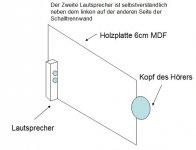
The setup in my office is fairly similar to how I used to set up my cars - I'm using horn loaded speakers in the office. Those JBLs linked in the post above.
In order to achieve a good soundstage I'm doing Ambio, but with a physical barrier instead of electronic processing.
Similar to this, but at my desk:

Something I should clarify:
In yesterday's post, I made an argument for why I think that car audio HLCDs are fundamentally flawed.
Something that I should note, is that I've designed a ton of car audio HLCDs!
Here's an anecdote:
I majored in art in college, and after a couple of years, one of my art teachers sat me down and basically said "Patrick, do you think you're good enough at art to pay your bills?" I slept on it, and the next day I changed my major to Computer Science.
At the time, I thought that my art teacher was basically trying to get me to drop out of college. As an adult, I realize that he was probably trying to get me to:
1) step my game up
2) or gently encourage me to try something else
So I look at these interactions with other members of the audio community in a similar fashion. When someone says "Patrick your car audio waveguides don't work!" I don't take offense, I just want to go back to the drawing board and figure out what it takes to improve them.
If I wasn't working so hard lately, I 100% would've taken a stab at making a new Unity horn for car audio. I think the one I made thirteen years ago worked pretty well and it would be interesting to see what I could do in 2022:
https://www.diymobileaudio.com/threads/creating-the-perfect-soundstage.60146/
In yesterday's post, I made an argument for why I think that car audio HLCDs are fundamentally flawed.
Something that I should note, is that I've designed a ton of car audio HLCDs!
Here's an anecdote:
I majored in art in college, and after a couple of years, one of my art teachers sat me down and basically said "Patrick, do you think you're good enough at art to pay your bills?" I slept on it, and the next day I changed my major to Computer Science.
At the time, I thought that my art teacher was basically trying to get me to drop out of college. As an adult, I realize that he was probably trying to get me to:
1) step my game up
2) or gently encourage me to try something else
So I look at these interactions with other members of the audio community in a similar fashion. When someone says "Patrick your car audio waveguides don't work!" I don't take offense, I just want to go back to the drawing board and figure out what it takes to improve them.
If I wasn't working so hard lately, I 100% would've taken a stab at making a new Unity horn for car audio. I think the one I made thirteen years ago worked pretty well and it would be interesting to see what I could do in 2022:
https://www.diymobileaudio.com/threads/creating-the-perfect-soundstage.60146/
- Home
- Loudspeakers
- Multi-Way
- The HOMster! (or How I Learned How to Fix a Horn)
